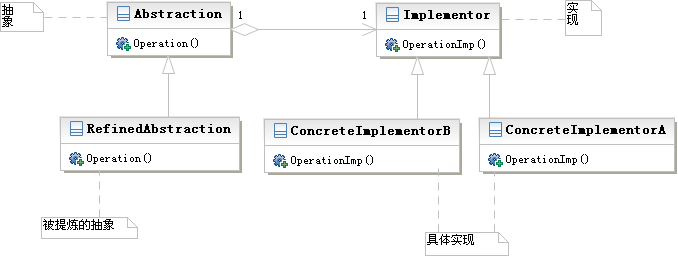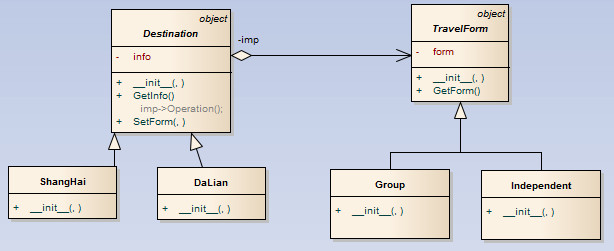Heim >Backend-Entwicklung >Python-Tutorial >实例解析Python设计模式编程之桥接模式的运用
实例解析Python设计模式编程之桥接模式的运用
- WBOYWBOYWBOYWBOYWBOYWBOYWBOYWBOYWBOYWBOYWBOYWBOYWBOriginal
- 2016-06-10 15:05:471347Durchsuche
我们先来看一个例子:
#encoding=utf-8
#
#by panda
#桥接模式
def printInfo(info):
print unicode(info, 'utf-8').encode('gbk')
#抽象类:手机品牌
class HandsetBrand():
soft = None
def SetHandsetSoft(self, soft):
self.soft = soft
def Run(self):
pass
#具体抽象类:手机品牌1
class HandsetBrand1(HandsetBrand):
def Run(self):
printInfo('手机品牌1:')
self.soft.Run()
#具体抽象类:手机品牌2
class HandsetBrand2(HandsetBrand):
def Run(self):
printInfo('手机品牌2:')
self.soft.Run()
#功能类:手机软件
class HandsetSoft():
def Run(self):
pass
#具体功能类:游戏
class HandsetGame(HandsetSoft):
def Run(self):
printInfo('运行手机游戏')
#具体功能类:通讯录
class HandsetAddressList(HandsetSoft):
def Run(self):
printInfo('运行手机通信录')
def clientUI():
h1 = HandsetBrand1()
h1.SetHandsetSoft(HandsetAddressList())
h1.Run()
h1.SetHandsetSoft(HandsetGame())
h1.Run()
h2 = HandsetBrand2()
h2.SetHandsetSoft(HandsetAddressList())
h2.Run()
h2.SetHandsetSoft(HandsetGame())
h2.Run()
return
if __name__ == '__main__':
clientUI();
可以总结出类图是这样的:

所以,桥接模式的概念在于将系统抽象部分与它的实现部分分离,使它们可以独立地变化。
由于目标系统存在多个角度的分类,每一种分类都会有多种变化,那么就可以把多角度分离出来,让它们独立变化,减少它们之间的耦合。
下面我们再来看一个实例:
基本原理请参考相关书籍,这里直接给实例
假期旅游 从目的地角度可以分为 上海和大连,从方式角度可以分为跟团和独体
桥接模式把这两种分类连接起来可以进行选择。
类图:

# -*- coding: utf-8 -*-
#######################################################
#
# tour.py
# Python implementation of the Class DaLian
# Generated by Enterprise Architect
# Created on: 11-十二月-2012 16:53:52
#
#######################################################
from __future__ import division
from __future__ import print_function
from __future__ import unicode_literals
from future_builtins import *
class TravelForm(object):
"""This class defines the interface for implementation classes.
"""
def __init__(self, form="stay at home"):
self.form=form
pass
def GetForm(self):
return self.form
pass
pass
class Group(TravelForm):
"""This class implements the Implementor interface and defines its concrete
implementation.
"""
def __init__(self, form="by group"):
super(Group,self).__init__(form)
pass
pass
class Independent(TravelForm):
"""This class implements the Implementor interface and defines its concrete
implementation.
"""
def __init__(self, form="by myself"):
super(Independent,self).__init__(form)
pass
class Destination(object):
"""This class (a) defines the abstraction's interface, and (b) maintains a
reference to an object of type Implementor.
"""
m_TravelForm= TravelForm()
def __init__(self, info):
self.info=info
pass
def GetInfo(self):
# imp->Operation();
return print(self.info + " " +self.form.GetForm())
pass
def SetForm(self, form):
self.form=form
pass
class DaLian(Destination):
"""This class extends the interface defined by Abstraction.
"""
def __init__(self, info="Go to DaLian "):
super(DaLian,self).__init__(info)
pass
class ShangHai(Destination):
"""This class extends the interface defined by Abstraction.
"""
def __init__(self, info="Go to ShangHai"):
super(ShangHai,self).__init__(info)
pass
#客户端
if(__name__=="__main__"):
destination=ShangHai()
destination.SetForm(Group())
destination.GetInfo()
destination=DaLian()
destination.SetForm(Independent())
destination.GetInfo()
运行结果

Stellungnahme:
Der Inhalt dieses Artikels wird freiwillig von Internetnutzern beigesteuert und das Urheberrecht liegt beim ursprünglichen Autor. Diese Website übernimmt keine entsprechende rechtliche Verantwortung. Wenn Sie Inhalte finden, bei denen der Verdacht eines Plagiats oder einer Rechtsverletzung besteht, wenden Sie sich bitte an admin@php.cn
Vorheriger Artikel:探究python中open函数的使用Nächster Artikel:Saltstack快速入门简单汇总

